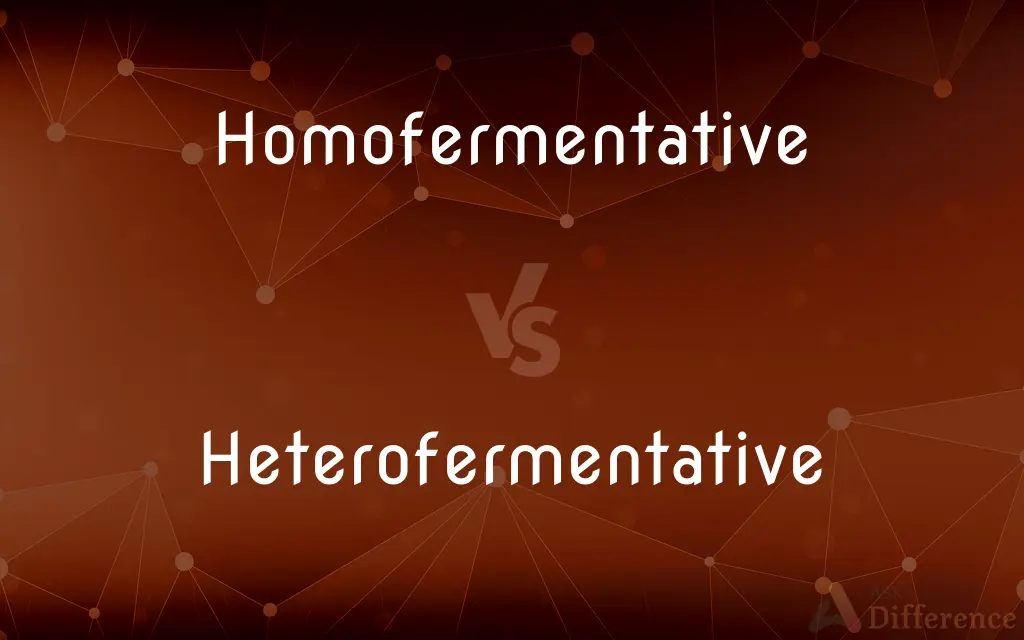Homofermentative vs. Heterofermentative — What's the Difference?
Edited by Tayyaba Rehman — By Maham Liaqat — Updated on April 8, 2024
Homofermentative bacteria convert sugars primarily into lactic acid, while heterofermentative bacteria produce lactic acid, CO2, and other compounds.

Difference Between Homofermentative and Heterofermentative
Table of Contents
ADVERTISEMENT
Key Differences
Homofermentative fermentation is characterized by the conversion of glucose primarily into lactic acid, utilizing pathways like the Embden-Meyerhof pathway, which results in a high yield of lactic acid from glucose. This process is employed by certain lactic acid bacteria that specialize in efficient lactic acid production. Whereas heterofermentative bacteria use the phosphoketolase pathway, leading to a mix of end products, including lactic acid, ethanol or acetic acid, CO2, and sometimes other compounds, from the fermentation of glucose. This diversity in fermentation products is due to the different enzymatic pathways utilized.
In terms of energy yield, homofermentative bacteria produce two molecules of ATP per molecule of glucose fermented, which is a direct outcome of their straightforward metabolic pathway. On the other hand, heterofermentative bacteria typically generate less ATP per molecule of glucose because their metabolic process involves the splitting of glucose into a variety of end products, not just lactic acid. This difference in energy yield reflects the efficiency of the two types of fermentation processes in converting glucose into energy.
Homofermentative lactic acid bacteria are often used in the dairy industry to produce yogurt, cheese, and other fermented dairy products due to their ability to produce large amounts of lactic acid, which helps in the preservation and flavoring of these products. Whereas heterofermentative bacteria find application in the production of certain types of cheese, sourdough breads, and fermented beverages, where the production of CO2 and other compounds contributes to the texture, flavor, and leavening of the products.
The preference for homofermentative or heterofermentative bacteria in industrial and food applications depends on the desired end products. Homofermentative fermentation is preferred when the primary goal is the production of lactic acid, such as in the making of most dairy products. In contrast, heterofermentative fermentation is chosen for the production of foods and beverages that benefit from a mix of fermentation products, including carbon dioxide and ethanol, which contribute to the product’s flavor profile and physical characteristics.
Understanding the differences between homofermentative and heterofermentative bacteria is crucial in biotechnology and food science. It allows for the optimization of fermentation processes according to the desired end products, whether that be in maximizing lactic acid production or in creating a diverse array of fermentation products to enhance food flavor and texture.
ADVERTISEMENT
Comparison Chart
Main Products
Lactic acid
Lactic acid, CO2, ethanol/acetic acid, others
Pathway Used
Embden-Meyerhof pathway
Phosphoketolase pathway
ATP Yield per Glucose
2 ATP
Less than 2 ATP
Application
Dairy products like yogurt and cheese
Sourdough breads, certain cheeses, fermented beverages
Desired Outcome
High lactic acid yield
Diverse fermentation products for flavor and texture
Compare with Definitions
Homofermentative
Utilizes the Embden-Meyerhof pathway for glucose breakdown.
Homofermentative bacteria efficiently convert glucose to lactic acid, employing the Embden-Meyerhof pathway.
Heterofermentative
Bacteria that produce a mix of fermentation products.
Leuconostoc mesenteroides, used in sauerkraut, is heterofermentative.
Homofermentative
Bacteria that primarily produce lactic acid from sugars.
Lactobacillus delbrueckii, used in yogurt production, is homofermentative.
Heterofermentative
Fermentation yielding lactic acid, CO2, and other compounds.
Heterofermentative processes are crucial for the unique texture and flavor of sourdough.
Homofermentative
A fermentation process yielding mostly one product.
Homofermentative fermentation is essential for the dairy industry’s consistent lactic acid production.
Heterofermentative
Results in diverse fermentation products enhancing food properties.
The heterofermentative method is preferred for its contribution to the complex flavors in fermented beverages.
Homofermentative
Characterized by a straightforward metabolic pathway.
The simplicity of the homofermentative process makes it preferred for certain food fermentations.
Heterofermentative
Employs the phosphoketolase pathway.
Through the phosphoketolase pathway, heterofermentative bacteria diversify the fermentation end products.
Homofermentative
A process optimizing lactic acid production.
Homofermentative fermentation is chosen to maximize lactic acid yield in cheese making.
Heterofermentative
Generates less ATP per glucose molecule.
Despite producing less energy, heterofermentative fermentation is valued for its product diversity.
Homofermentative
That produce (almost entirely) a single fermentation product (typically lactic acid)
Heterofermentative
That undergoes fermentation to produce more than one product, e.g. both alcohol and lactic acid.
Common Curiosities
Can a bacterium be both homofermentative and heterofermentative?
Some bacteria can switch between pathways under certain conditions, but they are generally classified as one or the other.
What are the main products of heterofermentative fermentation?
Lactic acid, CO2, ethanol or acetic acid, and possibly other compounds.
Why is ATP yield different in homofermentative and heterofermentative bacteria?
Due to their metabolic pathways; homofermentative bacteria have a more direct pathway yielding more ATP.
Why are homofermentative bacteria preferred in dairy production?
For their efficiency in producing large amounts of lactic acid, which is desirable in dairy fermentations.
What defines a homofermentative bacterium?
It primarily converts sugars into lactic acid using the Embden-Meyerhof pathway.
How does the choice between homofermentative and heterofermentative affect food flavor?
Heterofermentative fermentation introduces a broader range of flavors due to the diversity of end products.
Can the fermentation pathway of a bacterium change?
While bacteria typically stick to one pathway, environmental conditions can influence their metabolic processes.
Are all lactic acid bacteria either homofermentative or heterofermentative?
Yes, based on their metabolic pathways, they are classified into these two categories.
What is the phosphoketolase pathway?
Utilized by heterofermentative bacteria, it leads to a variety of fermentation products including lactic acid, CO2, and ethanol.
What role does CO2 play in heterofermentative fermentation?
CO2 contributes to the texture and leavening in foods like sourdough bread and certain cheeses.
What is the Embden-Meyerhof pathway?
A metabolic pathway used by homofermentative bacteria to efficiently convert glucose to lactic acid.
Share Your Discovery

Previous Comparison
Among vs. Across
Next Comparison
Private vs. HiddenAuthor Spotlight
Written by
Maham LiaqatEdited by
Tayyaba RehmanTayyaba Rehman is a distinguished writer, currently serving as a primary contributor to askdifference.com. As a researcher in semantics and etymology, Tayyaba's passion for the complexity of languages and their distinctions has found a perfect home on the platform. Tayyaba delves into the intricacies of language, distinguishing between commonly confused words and phrases, thereby providing clarity for readers worldwide.















































